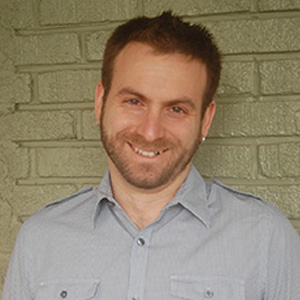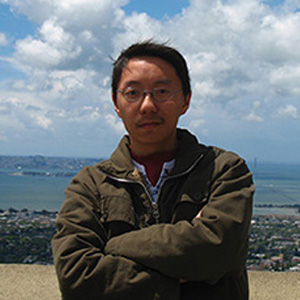Make it Seven in Seven
Associate Professor Steve Johnston and Assistant Professor Jian Liu have won prestigious early-career awards from the National Science Foundation, bringing the department’s total to seven NSF CAREER honors since 2012, with six current grants totaling more than $2.4 million. The awards came through the NSF’s Faculty Early Career Development (CAREER) Program, which supports faculty at the outset of their careers who have shown potential as role models in research and education.


Steve Johnston (left) and Jian Liu won National Science Foundation CAREER Awards to support their research in condensed matter physics. Johnston is a theorist and Liu is an experimentalist: both study the properties of nanoscale materials. Johnston joined the physics faculty in 2014; Liu came to UT in 2015.
Both Johnston and Liu will focus on the properties of quantum materials, which are at the forefront of condensed matter physics research. The rules for macroscopic objects don’t necessarily hold in the realm of subatomic—a pitched baseball’s path and velocity, for example, aren’t mimicked by an electron working through a metal. Johnston will develop new theoretical tools that will help scientists interpret findings from powerful experimental techniques, while Liu will investigate the hidden symmetry of quantum systems to develop new two-dimensional magnetic materials.
Of the 24 current National Science Foundation CAREER awards listed under the University of Tennessee, Knoxville, on the NSF website, six were awarded to physics faculty members. To date those grants have garnered more than $2.4 million.
Johnston’s research will help provide new theory frameworks to support current experiments using Resonant Inelastic X-Ray Scattering (RIXS) as well as develop time-resolved RIXS techniques. This method scatters an X-ray beam off a material’s electrons and in doing so can probe multiple properties in a single experiment, resulting in rich, yet complicated, data.
As Johnston explained, the remarkable properties of quantum materials often derive from a subtle interplay between their electronic, magnetic, and structural properties, and a central challenge for the community is to separate the drivers from the passengers. Tools like RIXS provide a way to study all of these interactions in a single experiment. But the tradeoff is that interpreting their findings can be a challenge without sophisticated theoretical models.
Johnston will work to develop theoretical approaches and computational codes that can help experimentalists determine what their data is truly measuring and what can be determined from those findings. The goal is that these theoretical tools will work across a broad range of quantum materials, including high-temperature superconductors and quantum spin liquids. Johnston described how, for example, scientists still aren’t certain if high-temperature superconductivity is driven purely by magnetic interactions, or if a material’s atomic lattice is lending a hand. He hopes to develop causal links for scenarios like this, in part by looking at time scales to see if effects are governed by slow or fast processes.
"This new information can give us clues as to which interaction is the driver and which is the passenger," he said.
He will be working with scientists from the Paul Scherrer Institute in Switzerland and hopes to expand his efforts to RIXS experimental groups in the U.S. His proposal also includes establishing a Bridge Program in the physics department. This American Physical Society initiative strengthens the wider physics community by increasing the number of graduate students from under-represented minorities via transition programs, mentoring, and networking. Johnston will also involve current students in his CAREER research.
Like Johnston, Jian Liu is also intrigued by the properties of quantum materials, specifically magnetism. He explained that new magnetic materials are necessary for developing a next generation of processors, memories, and sensors with better security, faster speed, and smaller size. His goal is to build—atomic layer by atomic layer—quantum antiferromagnets that can be controlled externally.
Quantum antiferromagnets are model systems that have great impact for condensed matter physics. For instance, high-temperature superconductivity is known to occur when metallizing quantum antiferromagnets. Their quantum mechanical nature can cause entanglement that is absent in ferromagnets. One chief challenge, however, is that antiferromagnets, unlike their ferromagnetic cousins, by nature resist being controlled by a magnetic field.
"Essentially the material likes to be the opposite of a ferromagnet," Liu said. "And what that means is that it doesn’t like to be in a magnetic field. So typically you have two choices. You either apply a magnetic field and get no response, or you apply a very large magnetic field and simply just destroy the antiferromagnetic order. That’s usually the only two possible outcomes."
By using laser deposition to synthesize precise two-dimensional oxide materials and implement a hidden symmetry in their structure, Liu sees the promise of overcoming this challenge.
"If you can make things two-dimensional rather than three-dimensional, you save a lot of room—a lot of space,” he said. “You basically scale things down to as thick as one atom."
He will take advantage of the hidden rotational symmetry in the materials’ spin—where a magnetic field will couple to alternating quantum spins and in doing so cause the material to respond like a ferromagnet. This will require Liu to precisely engineer these tiny structures, designing every minute detail about their thickness, composition, and structural distortions and then study the magnetism in samples a million times thinner than a human hair. He’ll do this work in his lab at the UT-ORNL Joint Institute for Advanced Materials and with collaborators at synchrotron facilities. Liu will share his research through the department’s Saturday Morning Physics program and Faceback live chats. He will also work with the university’s Governor’s School for the Sciences and Engineering and will reach out to area high schools with potential student projects. Like Johnston, Liu is encouraging students from under-represented groups to take part.
"We are going to invite students from minority-serving institutions to do a project in the summer," he said. "We will try to build a long-term collaboration with those institutions."
Liu also has an eye on incorporating his research into the department’s undergraduate physics courses. Having taught for three years he sees that students need examples of the physics behind the ever-evolving smart devices they use every day.
"That’s what they’re going to be dealing with in their future careers," he said. "It would be beneficial for them to see the bridge between the physics they learn in the textbook and the technology they embrace in life."